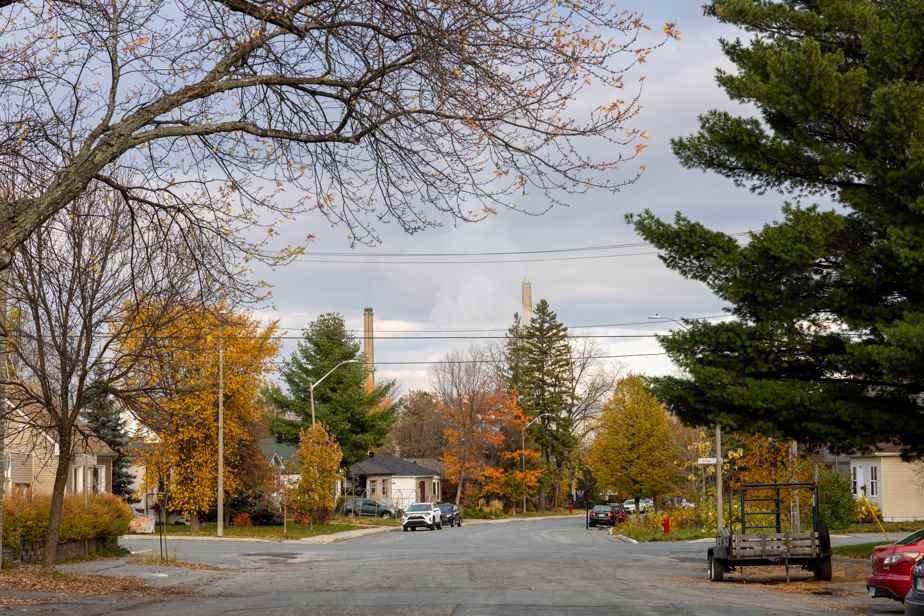Posted at 5:00 a.m.
(Rouyn-Noranda) “My child is playing in the yard here,” exclaims Félix B. Desfossés, who would like to know the level of contamination on his land, in the Sacré-Coeur district of Rouyn-Noranda.
The Horne Foundry, which has been releasing contaminants into the air for nearly a century, is only 500 meters from his home, in the Notre-Dame district.
This pollution “does not magically stop at the track of railroad” which separates the two districts, launches Louis-Paul Willis, another resident of the Sacré-Coeur district, who would also like to know what is in his land.
But the Legault government refuses to characterize the soils throughout the city, as the Public Health Department (DSPu) of Abitibi-Témiscamingue has officially recommended to it, and limits itself to those of the Notre-Dame district – the characterization of around a hundred residential lots is being carried out this fall, under the responsibility of the Horne Foundry.

PHOTO DOMINIC LECLERC, SPECIAL COLLABORATION
Marie-France Beaudry and Louis-Paul Willis, residents of Rouyn-Noranda
The DSPu made this recommendation in its Report of the preliminary characterization of soils with arsenic, cadmium and lead in the urban perimeter of Rouyn-Norandapublished in 2020, and reiterated it in the notice it filed this month during the public consultation on the renewal of the ministerial authorization of the Horne Foundry.
The 2020 report revealed that nearly a quarter of the 156 residential lots sampled in Rouyn-Noranda exceeded the threshold provided for in Quebec regulations for cadmium, 6%, the threshold for arsenic and 3%, that for lead, and that most of these lands are located on the south shore of Lake Osisko, downtown, as well as in the Sacré-Coeur district.
Question of priorities
The Ministry of the Environment and the Fight against Climate Change (MELCC) assumes its refusal not to carry out soil characterization throughout the city, as recommended by Public Health.
After analyzing the issues and the relevance of this request, it was agreed [avec le ministère de la Santé et des Services sociaux] that the MELCC would not carry out an exhaustive characterization of the soils of the urban perimeter of Rouyn-Noranda.
Ghizlane Behdaoui, spokesperson for the Ministry of the Environment and the Fight against Climate Change
“We must consider that the priority remains the reduction of atmospheric emissions,” she added.
However, measuring land contamination is important because “the ingestion of soil and dust represents a greater risk [d’absorber des contaminants] than by ingesting air,” explained to The Press Stéphane Bessette, team leader in environmental health at the DSPu.
“If the foundry stops its emissions tomorrow morning, we are still with the problem”, since the contamination of the soil is the result of past contamination of the air, adds the one who is one of the main authors of the 2020 report.
Know to act
A characterization of the soil throughout the city would make it possible to identify the contaminated land to be rehabilitated, emphasizes Stéphane Bessette.
It would also allow the passage to reassure certain people, whose land may be little or not contaminated, thinks Julien Rivard, who lives in the Sacré-Coeur district.
He himself is “not really worried”, considering that his property is not in the corridor of the prevailing winds, but he would like to have “the data to prove it”.
The exercise would nevertheless reveal that thousands of lands need to be rehabilitated, he believes.
I think neither the Ministry of the Environment nor the Foundry want to see that.
Julien Rivard, citizen of Rouyn-Noranda
“I think they know very well what the result would be,” adds Félix B. Desfossés, who is a well-known figure in the region for having hosted the return home program there on Radio Radio until 2021. -Canada.
Worried about the pollution generated by the Horne Foundry, worried about the future of his son and no longer having confidence in the Ministry of the Environment, he decided to leave the neighborhood which saw him grow up to settle outside the city.
Voices are added
Other voices calling for the characterization of soils throughout the urban perimeter of Rouyn-Noranda were added in the wake of the public consultation on the renewal of the ministerial authorization of the Horne Foundry, which ended on 20 october.
The Abitibi-Témiscamingue Regional Council for the Environment recommends this in its brief, regretting that the current characterization “concerns only the Notre-Dame district”.
The National Grouping of Regional Councils for the Environment also calls for it, as does the Stop Toxic Discharges and Emissions Committee (ARET).

DOMINIC LECLERC, SPECIAL COLLABORATION.
Nicole Desgagnés, from the Rouyn-Noranda Toxic Discharges and Emissions Stop Committee (ARET)
“It’s not normal that we don’t go further”, declared to The Press Nicole Desgagnés, spokesperson for the ARET committee, accusing Quebec of wanting to divide the population by suggesting that the problem only concerns the Notre-Dame district.
A characterization in the entire city would be a colossal task, recognizes Stéphane Bessette, of Public Health, but it would give a complete portrait of the situation.
“We all know that it won’t happen overnight, he says, but if we had a horizon, a plan, we would already be more advanced than now. »
Learn more
-
- 43,092
- Population of the city of Rouyn-Noranda
source: Quebec Ministry of Municipal Affairs and Housing

